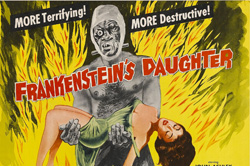Greece, Italy, Argentina: a financial horror story
Monday, November 28, 2011

The issue: how to prevent a sequel.
Fred Blaser *
Other than the fact that few people saw it coming, there’s nothing remarkable about the implosion of the economies of Greece and Italy.
The two countries are following a script - basically a horror movie - which Argentina wrote a decade before, based on an earlier version by Mary Shelley.
In the story of Frankenstein, a medical expert tries miraculously to create human life, by inserting a brain into spare body parts.
In Argentina, several financial experts believed that switching to a foreign currency would be a miracle cure for an economic crisis.
The reason for the experiment was understandable in each case.
Frankenstein was fiction.
But the concept of galvanism - turning inanimate objects into living things – was plausible in 1818, when Shelley published her novel.
Meanwhile, Argentina twenty years ago had an annual inflation rate of nearly 5,000 per cent.
Few companies wanted to invest in the country, or to hire people.
In these circumstances, then-President Carlos Menem and his Finance minister, Domingo Cavallo, thought that pegging the value of the peso to the United States dollar would be a magic bullet.
The plan worked: when you can’t print as much money as you want, inflation disappears.
Unfortunately, their creature, like that of Doctor Frankenstein, was out of control.
A strong currency works fine in a competitive economy.
But if a country is no more productive than its neighbors, having a hard currency can be scary.
For its part, Argentina in the 1990s was no more efficient than Brazil, which exports many of the same goods and services.
The difference is that when foreign importers rejected the price of Brazilian exports, the value of the real fell, to the point at which buyers would make a deal.
Between 1996 and 2001, the real obligingly lost half its value against the United States dollar.
The only way for an Argentine exporter to compete with its Brazilian counterpart would have been to pay less to suppliers and workers.
But few workers would accept pay cuts of close to half their income in any country, let alone in Peronist Argentina (our slogan: “ You name it, we promise to give it to you.”).
A country, which can’t cut the price of uncompetitive goods and services, won’t sell to others.
In this case, the next act of the drama involves borrowing as much money as the country can, while praying for some combination of a falling dollar and a rise in the value of the neighbor’s currency, or - failing that - going broke, which Argentina did in 2001.
The European story is similar.
Italy in 1999 and Greece two years later adopted the Euro, a new currency, which would help rejuvenate the old continent.
But the baby turned vicious.
Neither Greece nor Italy was - or is - competitive with many of its neighbors.
The result has been that the two countries are stuck with the task of selling goods and services in Euros, the value of which they can’t change.
Greece and Italy can try to become efficient.
Businesses can invest more in technology and training.
Companies can stop offering bribes to public officials, who can refuse to take them.
Both countries can improve the quality of public education.
But it takes years of effort to change human behavior, assuming the people involved are interested in the concept in the first place.
The rest of Europe could push for an even closer union.
In this scenario, if Greece and Italy want money from competitive countries, they would accept advisors from those countries, who help run the Greek and Italian governments.
But getting Greek and Italian nationalists to agree to joint management with Berlin and Brussels would be a hard sell.
The alternative is for Greece and Italy go back to their old currencies.
Re-issuing drachmas and liras would be a big administrative pain.
Lenders to both countries would lose money.
Dealing with more currencies means having to calculate exchange rates, and paying a fee, each time a company or person needs to trade a Euro to Greeks and Italians.
But Argentina had to deal with most of the same issues, when it detached the peso from the dollar a decade ago.
Meanwhile, economic growth during the next six years was Argentina’s highest in over a century.
Since 2005, purchasing power per person has risen by a robust 33%.
Much of the increase in wealth has come from a record-setting surge in exports, thanks mainly to a competitive currency.
Argentina has other problems.
But when the peso crashed, Argentina drove a stake through the heart of the monster.
* Published in the Globe and Mail, November 23, 2011
